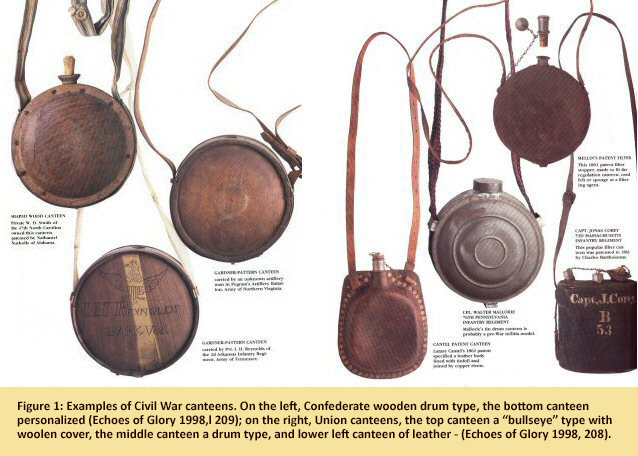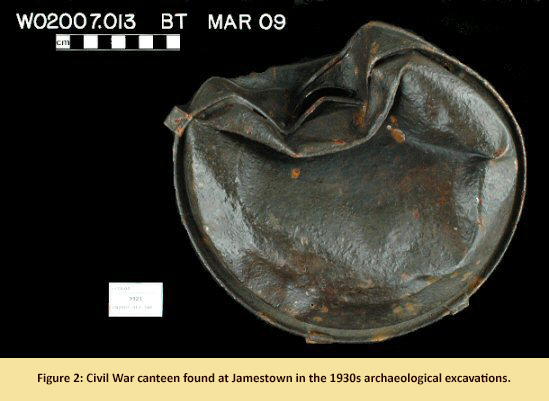Civil War Canteen
May 2009
By Nancy S. Shippen, MAC Lab Conservator
Because Jamestown is known primarily for its role in establishing the British colonies in America, little is discussed about the activities that took place on the island during the Civil War period. Just as the location was an important strategic outpost for the English colonists in 1607, the Confederates looked to Jamestown Island as the best defensive location to protect Richmond, the capital of the South and a major industrial center in 1861 (Riggs 1997). In the building of embankments and digging moats for the Confederate earthen fort, some of the dirt from the original James Fort was incorporated. Excavation of the Civil War trenches in the 1950s, and again in 1994, led to the discovery of the James Fort (Kelso, 2006). Jamestown was occupied by both Confederate and Federal forces throughout the war.
After the move of the capital of colonial government from Jamestown to Williamsburg in 1699, the island reverted to agricultural fields and the property passed through several hands. By 1861, the island eventually consolidated to one owner, Captain William Allen (Jamestown Archaeological Assessment 2002). Captain Allen occupied the island with Confederate troops raised at his own expense. They constructed five earthworks to protect the island and control the river traffic to prevent the capture of Richmond. As more troops were added, additional fortifications were constructed. When Yorktown was besieged in 1862, the Confederates evacuated. Federal troops then occupied Jamestown, connecting the island to the War Department in Washington by telegraph wire. Jamestown, however, was largely ignored until 1863 when both Confederate and Union forces used the location in diversionary tactics, during the Confederate Suffolk campaign and later during the Gettysburg campaign, the Federal troops made a feint against Richmond. Later in 1863, Jamestown was a Union outpost and a communications link for Williamsburg, and a telegraph cable extended underwater from Jamestown to Fort Powhatan to Union headquarters at City Point. At the end of the Civil War, after the surrender of the Confederate army at Appomattox, the Oath of Allegiance was administered at Jamestown (Riggs 1997).
An essential piece of equipment for any soldier, there were many types and designs of canteens used by both armies. A classic design of the Federal forces after 1861 was the metal “bullseye” type (Model 1858) where rings were pressed into both sides of the canteen. Canteens made of wood or leather were also used, and they could be personalized by carving into the wood or painting the cloth cover with their owner’s name and company number (Field and Smith 2005).

Companies that produced large quantities of canteens were located primarily in the North, so Confederate soldiers had to rely on wooden canteens, crude blacksmith products, or whatever could be found on the battlefield. Despite having greater access to canteens, the North still had difficulty providing the necessary quantity, and found they had an increase in problems, such as leaking, due to the number of different manufacturers used (Jones 2007).
The canteen would have been issued with a dyed wool or cotton cover, some with a leather sling. The cover, in particular wool, would not only provide padding to prevent a leak if dropped and to muffle sound, but also would help cool the canteen through evaporation. The covers were produced through a mixture of machine and hand sewing, each modified by the soldier to fit. Often the canteen covers would be removed and used for patching uniforms.
This Civil War canteen, found in archaeological excavations in Jamestown in the 1930s, is known as a drum type and could have been used by either the Confederate or Union army. Originally, the canteen was round with a wide band and three loops for straps. The drum canteen was considered inferior to the lighter “bullseye” canteen.
 .
.
| References |
|
| Echoes of Glory |
| 1998 |
Arms and Equipment of The Union. Time Life Books, Alexandria. |
| 1998 |
Arms and Equipment of The Confederacy. Time Life Books, Alexandria. |
|
| Field, Ron and Robin Smith |
| 2005 |
Uniforms of the Civil War. The Lyons Press, Guilford. |
|
| Jamestown Archaeological Assessment |
| 2002 |
National Park Service, U.S. Department of Interior. U.S. Library of Congress, Washington DC. |
|
| Jones, Robert |
| 2007 |
The Civil War Canteen. Lulu.com. |
|
| Kelso, William M. |
| 2006 |
Jamestown: The Buried Truth. University of Virginia Press, Charlottesville. |
|
| Riggs, David F. |
| 1997 |
Embattled Shrine: Jamestown in the Civil War. White Mane Publishing Co., Shippensburg. |
|